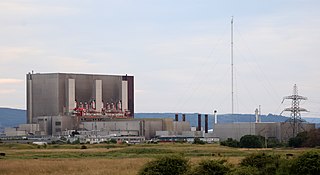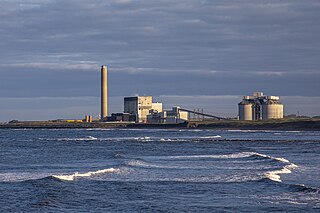
Drax power station is a large biomass power station in Drax, North Yorkshire, England, capable of co-firing petroleum coke. It has a 2.6 GW capacity for biomass and had a 1.29 GW capacity for coal that was retired in 2021. Its name comes from the nearby village of Drax. It is situated on the River Ouse between Selby and Goole. Its generating capacity of 3,906 megawatts (MW), which includes the shut down coal units, is the highest of any power station in the United Kingdom, providing about 6% of the United Kingdom's electricity supply.

Hartlepool nuclear power station is a nuclear power station situated on the northern bank of the mouth of the River Tees, 2.5 mi south of Hartlepool in County Durham, North East England. The station has a net electrical output of 1,185 megawatts, which is 2% of Great Britain's peak electricity demand of 60 GW. Electricity is produced through the use of two advanced gas-cooled reactors (AGR). Hartlepool was only the third nuclear power station in the United Kingdom to use AGR technology. It was also the first nuclear power station to be built close to a major urban area.

Teesside Power Station is a former gas-fired power station, in Redcar & Cleveland, England. Situated near the Wilton chemical complex, the station had combined cycle gas turbines (CCGTs) and open cycle gas turbines (OCGTs), however in 2011 the operation of the CCGT part of the station was suspended, and in 2013 the owners announced its closure and plans to demolish it. Prior to the suspension, the station had a generating capacity of 1875 megawatts (MW), making it the largest of any CCGT power station in Europe. The station could meet almost 3% of the electricity demand for England, Wales and Scotland. Opened in 1993, the station was initially operated by Enron but moved into the hands of PX Ltd after the Enron scandal of 2001, before being bought by Gaz de France and Suez in 2008. The station also worked as a cogeneration plant, providing steam for the Wilton complex.

Eggborough power station was a coal-fired power station in North Yorkshire, England, which was capable of co-firing biomass. It was situated on the River Aire, between the towns of Knottingley and Snaith, deriving its name from the nearby village of Eggborough. The station had a generating capacity of 1,960 megawatts, enough electricity to power 2 million homes, equivalent to the area of Leeds and Sheffield.

Renewable energy in the United Kingdom contributes to production for electricity, heat, and transport.

Lynemouth Power Station is a biomass power plant which provides electricity for the UK National Grid. Until March 2012, it was the main source of electricity for the nearby Alcan Lynemouth Aluminium Smelter. It is located on the coast of Northumberland, north east of the town of Ashington in north east England. The station has stood as a landmark on the Northumberland coast since it opened in 1972, and had been privately owned by aluminium company Rio Tinto Alcan throughout its operation until December 2013, when RWE npower took over. In January 2016 it was acquired by Energetický a průmyslový holding.

The Wilton power station refers to a series of coal, oil, gas and biomass fired CHP power stations which provide electricity and heat for the Wilton International Complex, with excess electricity being sold to the National Grid. It is located on the Wilton site in Redcar and Cleveland, south of the town of Middlesbrough in North East England. The station has provided for the site since opening in 1952, when it was operated by ICI. The station is currently owned and operated by SembCorp Industries.

Teesside Energy from Waste plant is a municipal waste incinerator and waste-to-energy power station, which provides 29.2 megawatts (MW) of electricity for the National Grid by burning 390,000 tonnes of household and commercial waste a year. It is located on the River Tees at Haverton Hill, east of Billingham in North East England. Developed and built by NEM, a subsidiary of Northumbrian Water, the initial plant replaced the Portrack Incinerator and opened in 1998. Subsequently, the facility became part of SITA, now Suez.

Thor Cogeneration is a planned, but undeveloped, gas-fired cogeneration plant, which was to be built on Seal Sands near Billingham, in County Durham, North East England.

The North Blyth Biomass Project was a proposed biomass-fired power station planned to be located at North Blyth, Northumberland on the north bank of the River Blyth near its tidal estuary. When commissioned it would have had a generating capacity of 100 megawatts, enough electricity to provide for 170,000 homes. Renewable Energy Systems, the station's developer, was granted government consent on 24 July 2013 to build the £250m project.
Tees Renewable Energy Plant is a proposed biomass fueled power station situated on the River Tees at Teesport in Redcar and Cleveland, North East England. The plant will operate alongside other renewable energy units and industrial processes operating in the Northeast of England Process Industry Cluster (NEPIC)

As of 2019, renewable energy in Morocco covered 35% of the country’s electricity needs.
Eston Grange Power Station was a proposed power station to be situated near to Eston in Redcar and Cleveland. If built, it would have been the UK's first pre-combustion carbon capture and storage (CCS) plant. The station could have generated up to 850 megawatts of electricity, enough to supply around a million people with electricity. The station would use standard oil refinery technology to turn gasified coal into hydrogen and carbon dioxide.
Billingham Biomass Power Station is a planned biomass power station, that is to be built on the River Tees at Billingham. It is to be built on the site of the former coal-fired North Tees Power Station. The station will have a generating capacity of 45 megawatts (MW).
Tyne Renewable Energy Plant was a proposed biomass power station, to be built on the north bank of the River Tyne at North Shields. The plant was developed by MGT Power, along with their similar project, the Teesport Renewable Energy Plant on Teesside. It was expected to have a generating capacity of 295 megawatts, enough to power around 600,000 homes, meaning it would have been one of the biggest of its kind in Europe. It was originally hoped the plant would be opened in 2014, costing £400 million.
Renewable energy in Russia mainly consists of hydroelectric energy. Russia is rich not only in oil, gas and coal, but also in wind, hydro, geothermal, biomass and solar energy – the resources of renewable energy. Practically all regions have at least one or two forms of renewable energy that are commercially exploitable, while some regions are rich in all forms of renewable energy resources. However, fossil fuels dominate Russia’s current energy mix, while its abundant and diverse renewable energy resources play little role.
Atlantic Gateway, sometimes referred to as Ocean Gateway, is a proposed redevelopment strategy for North West England, centering on the corridor between Greater Manchester and Merseyside. The proposal is for development backed by £50 billion of investment over 50 years, making it one of the most expensive and expansive development projects in UK history.

Biomass Energy Centre is a biomass fired CHP power station located in the town of Chilton in County Durham. Opened in 2011, the plant was developed, and then owned and operated by Veolia Energy-Dalkia.
Templeborough Power Station is a biomass power station situated in Templeborough on the River Don in Rotherham England. Operated by Copenhagen Infrastructure Partners, it opened in 2018 with an operating capacity of 44 megawatts.
The Whitetail Clean Energy is a proposed power station in Wilton, Redcar and Cleveland, England. The generating process of the plant is listed as a "clean energy source", using natural gas and oxygen in a Allam-Fetvedt Cycle to create power. The excess carbon dioxide not used by the co-generation process is intended to be captured and stored under the North Sea, making the plant the first in the United Kingdom to utilise this type of technology, and also using carbon sequestration under the North Sea. The plant is also included in the Net Zero Teesside project. The power plant is proposed to start generating in 2025.














